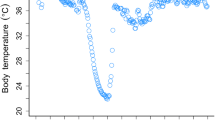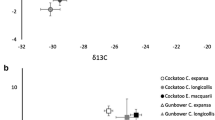Abstract
Spinner dolphins (Stenella longirostris) feed on individual small (2–10 cm long) prey that undergo diel vertical migrations, presumably making them inaccessible to dolphins during the day. To examine how time, prey behavior, prey distribution, and energy needs constrain dolphin foraging, a calorimeter was used to measure the caloric content of prey items. These data were combined with information on prey distribution in the field and the energetic needs of dolphins to construct basic bioenergetic models predicting the total prey consumption and mean feeding rates of wild dolphins as well as potential prey preferences. The mean caloric density of mesopelagic animals from Hawaii was high (2,837 cal/g wet weight for shrimps, squids, and myctophid fishes). Their total caloric content, however, was low because of their small size. Energy value of prey and energetic needs of spinner dolphins were used to examine the effect of time and energy constraints on dolphin foraging. The results predict that spinner dolphins need to consume an estimated minimum of 1.25 large prey items per minute to meet their maintenance energy needs. If the additional energy costs of foraging are considered, the estimated necessary foraging rate is predicted to increase only slightly when large prey are consumed. If smaller prey are consumed, the total energy demand may be twice the basic maintenance value. Prey density and size are predicted to be important in determining if dolphins can forage successfully, meeting their energetic needs. The prey size predictions compare well with results from previous gut content studies and from stomach contents of a recently stranded spinner dolphin that had enough prey in its stomach to meet its estimated basic maintenance energy needs for a day. Finally, the results suggest that spinner dolphins are time and therefore efficiency limited rather than being limited by the total amount of available prey. This may explain the diel migration exhibited by spinner dolphins that allows them to follow the movements of their prey and presumably maximizes their foraging time.







Similar content being viewed by others
References
Acevedo-Gutierrez A, Croll DA, Tershy BR (2002) High feeding costs limit dive time in the largest whales. J Exp Biol 205:1747–1753
Arnaya IN, Sano N, Iida K (1989a) Studies on acoustic target strength of squid II. Effect of behaviour on averaged dorsal aspect target strength. Bull Fac Fish Hokkaido Univ 40:83–99
Arnaya IN, Sano N, Iida K (1989b) Studies on acoustic target strength of squid III. Measurement of the mean target strength of small live squid. Bull Fac Fish Hokkaido Univ 40:110
Benoit-Bird KJ, Au WWL (2001) Target strength measurements of animals from the Hawaiian mesopelagic boundary community. J Acoust Soc Am 110:812–819
Benoit-Bird KJ, Au WWL (2002) Energy: converting from acoustic to biological resource units. J Acoust Soc Am 111:2070–2075
Benoit-Bird KJ, Au WWL (2003a) Prey dynamics affect foraging by a pelagic predator (Stenella longirostris) over a range of spatial and temporal scales. Behav Ecol Sociobiol 53:364–373
Benoit-Bird KJ, Au WWL (2003b) Spatial dynamics of a nearshore micronekton sound-scattering layer. ICES J Mar Sci 60:899–913
Benoit-Bird KJ, Au WWL, Brainard RE, Lammers MO (2001) Diel horizontal migration of the Hawaiian mesopelagic boundary community observed acoustically. Mar Ecol Prog Ser 217:1–14
Brooks AH (1977) A study of the swimbladders of selected mesopelagic fish species. In: Andersen NR, Zahuranec BJ (eds) Oceanic sound scattering prediction. Plenum Press, New York, pp 565–590
Bunce A (2001) Prey consumption of Australasian gannets (Morus serrator) breeding in Port Phillip Bay, southeast Australia, and potential overlap with commercial fisheries. ICES J Mar Sci 58:904–915
Burke BJ, Rice JA (2002) A linked foraging and bioenergetics model for southern flounder. Trans Am Fish Soc 131:120–131
Cadenat J, Doutre M (1959) Notes sur les delphinides Ouest-Africains, 5. Sur un Prodelphinus a long bec capture au large des cotes du Senegal: Prodelphinus longirostris. Bull Inst Fondam Afr Noire 21:787–792
Clarke M, Young RE (1998) Description and analysis of cephalopod beaks from stomachs of six species of odontocete cetaceans stranded on Hawaiian shores. J Mar Biol Assoc UK 78:623–641
Cowles DL (2001) Swimming speed and metabolic rate during routine swimming and simulated diel vertical migration of Sergestes similis in the laboratory. Pac Sci 55:215–226
Cox M, Gaglione E, Prowten P, Noonan M (1996) Food preferences communicated via symbol discrimination by a California sea lion (Zalophus californianus). Aquat Mamm 22:3–10
Day DE, Mintz EM, Bartness TJ (2002) Diet choice exaggerates food hoarding, intake and pup survival across reproduction. Physiol Behav 75:143–157
Dolar MLL, Walker WA, Kooyman GL, Perrin WF (2003) Comparative feeding ecology of spinner dolphins (Stenella longirostris) and Fraser’s dolphins (Lagenodelphis hosei) in the Sulu Sea. Mar Mamm Sci 19:1–19
Dufour DL, Reina JC, Spurr GB (2002) Energy intake and expenditure of free-living, lactating Colombian women in an urban setting. Eur J Clin Nutr 56:205–213
Fitch JE, Brownell RL Jr (1968) Fish otoliths and their importance in interpreting feeding habits. J Fish Res Bd Can 25:2561–2574
Gorman ML, Mills MG, Raath JP, Speakman JR (1998) High hunting costs make African wild dogs vulnerable to kleptoparasitism by hyaenas. Nature 391:479–481
Honda S, Wada T, Matsubara T (1992) Relationship between food consumption and growth of Japanese sardine Sardinops melanostictus in the laboratory. Bull Fac Fish Hokkaido Univ 56:1–6
Kastelein RA, Elst CA van der, Tennant HK, Wiepkema PR (2000) Food consumption and growth of a female dusky dolphin (Lagenorhynchus obscurus). Zoo Biol 19:131–142
Kastelein RA, Au WWL, de Haan D (2002a) Underwater audiogram of a striped dolphin (Stenella coeruleoalba) measured with narrow-band frequency-modulated signals. J Acoust Soc Am 112:334–344
Kastelein RA, Vaughan N, Walton S, Wiepkema PR (2002b) Food intake and body measurements of Atlantic bottlenose dolphins (Tursiops truncatus) in captivity. Mar Environ Res 53:199–218
Kils U (1979) Swimming speed and escape capacity of Antarctic krill, Euphausia superba. Rep Mar Res 27:264–266
Kizevetter IV (1973) Chemistry and technology of Pacific fish. The Israel Program for Scientific Translations (trans). U.S. Department of Commerce, National Technical Information Service, Springfield, Va., ‘IT72–50019 (Original work published 1971)
MacLennan DN, Simmonds EJ (1992) Fisheries acoustics. Chapman and Hall, New York
Martensson PE, Lager Gotaas AR, Nordoy ES, Blix AS (1996) Seasonal changes in energy density of prey of northeast Atlantic seals and whales. Mar Mamm Sci 12:635–640
Norris KS, Dohl TP (1980) Behavior of the Hawaiian spinner dolphin, Stenella longirostris. Fish Bull 77:821–849
Norris KS, Würsig B, Wells RS, Würsig M (1994) The Hawaiian spinner dolphin. University of California Press, Berkeley, Calif.
Perrin WF, Warner RR, Fiscus CH, Holts DB (1973) Stomach contents of porpoise, Stenella spp., and yellowfin tuna, Thunnus albacares, in mixed-species aggregations. Fish Bull 71:1077–1092
Perrin WF, Dolar MLL, Robineau D (1999) Spinner dolphins (Stenella longirostris) of the western Pacific and southeast Asia: Pelagic and shallow-water forms. Mar Mamm Sci 15:1029–1053
Reid SB (1994) Spatial structure of the mesopelagic fish community in the Hawaiian boundary region. Ph.D. dissertation, Department of Oceanography, University of Hawaii, Honolulu
Reid SB, Hirota J, Young RE, Hallacher LE (1991) Mesopelagic-boundary community in Hawaii: micronekton at the interface between neritic and oceanic ecosystems. Mar Biol 109:427–440
Sambilay VC Jr (1990) Interrelationships between swimming speed, caudal fin aspect ratio and body length of fishes. Fishbyte 83:16–20
Schotten M, Au WWL, Lammers MO, Aubauer R (2004) Echolocation recordings and localizations of wild spinner dolphins (Stenella longirostris) and pantropical spotted dolphins (Stenella attenuata) using a four hydrophone array. In: Thomas JA, Moss C, Vater M (eds) Echolocation in bats and dolphins. University of Chicago Press, Chicago (in press)
Smith RL, Paul JM, Gillispie J (1997) Energy content of Arctic cod and saffron cod in the northeastern Chukchi Sea. In: Reynolds JB (ed) Fish ecology in Arctic North America. American Fisheries Society, Symposium 19. American Fisheries Society, Bethesda, Md., pp 319–325
Stockwell JD, Johnson BM (1999) Field evaluation of a bioenergetics-based foraging model for kokanee (Oncorhynchus nerka). Can J Fish Aquat Sci 56:140–151
Urick RJ (1983) Principles of underwater sound. McGraw Hill, New York
Williams TM, Haun JE, Friedl W (1999) The diving physiology of bottlenose dolphins (Tursiops truncatus) I. Balancing the demands of exercise for energy conservation at depth. J Exp Biol 202:2739–2748
Yatsu A, Yamanaka K, Yamashiro C (1999) Tracking experiments of the jumbo flying squid, Dosidicus gigas, with an ultrasonic telemetry system in the eastern Pacific Ocean. Bull Natl Res Inst Far Seas Fish 36:55–60
Yazdi P, Kilian A, Culik BM (1999) Energy expenditure of swimming bottlenose dolphins (Tursiops truncatus). Mar Biol 134:601–607
Acknowledgements
Marlee Breese, Paul Nachtigall, and Robert Braun of the Hawaiian Islands Stranding Response Group provided information on the stranded animal and extracted and saved its stomach under Dr. Braun’s Letter of Authorization from the National Marine Fisheries Service. Iris Fischer, Michiel Schotten, Marc Lammers, Whitlow Au, and Ariel Rivera-Vicente assisted in the dissection of the stomach. Timothy Tricas generously permitted me to utilize his laboratory and Ariel Rivera-Vicente made sure I had everything I needed. Gayla Ivey and Ken Longenecker assisted with the classification of fish otoliths. Whitlow Au, Paul Nachtigall, and George Losey provided helpful comments on earlier drafts of this manuscript. Support for this work was provided by a Leonida Family Scholarship, the ARCS Foundation, and the Hawaii Institute of Marine Biology’s Marine Mammal Research Program. This work was also funded by a grant from the National Oceanic and Atmospheric Administration, Project R/FM-7, which is sponsored by the University of Hawaii Sea Grant College Program, SOEST, under Institutional Grant No. NA16RG2254 from NOAA Office of Sea Grant, Department of Commerce. The views expressed herein are those of the author and do not necessarily reflect the views of NOAA or any of its subagencies. UNIHI-SEAGRANT-JC-03–01 This is HIMB contribution 1172.
Author information
Authors and Affiliations
Corresponding author
Additional information
Communicated by P.W. Sammarco, Chauvin
Rights and permissions
About this article
Cite this article
Benoit-Bird, K.J. Prey caloric value and predator energy needs: foraging predictions for wild spinner dolphins. Marine Biology 145, 435–444 (2004). https://doi.org/10.1007/s00227-004-1339-1
Received:
Accepted:
Published:
Issue Date:
DOI: https://doi.org/10.1007/s00227-004-1339-1




